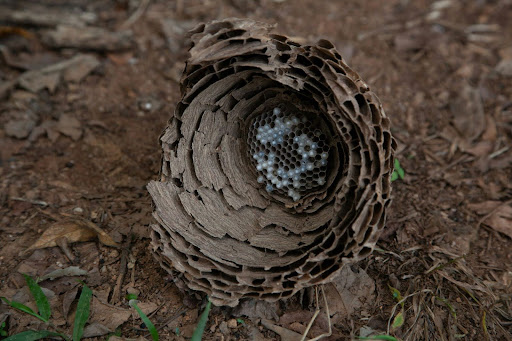Imagine stepping out into your garden on a sunny afternoon only to spot a buzzing flurry around what looks like a ball of paper hanging under your eaves. Is it a wasp nest or a bee nest? Do you need to panic?
Knowing the difference is crucial, especially since up to 5% of people are allergic to stings.
When you think of bees and wasps, you might picture them buzzing around flowers or hovering over a picnic basket. But their nests are where the magic happens.
Understanding how these nests differ can help you identify whether you’re dealing with a friendly neighborhood pollinator or a potential pest.
Appearance Matters
The first key to detecting the differences is to pay closer attention to the appearance of the nests.
Wasp nests typically look like they’re made of paper. That’s because they are! Wasps chew up wood fibers mixed with their saliva to create a papery pulp. These nests often have a grayish hue and can resemble an umbrella. You’ll usually find them in sheltered locations like under eaves, within wall cavities, or hanging from tree branches.
Bee nests (or hives), especially those of honeybees, are quite different. Honeybees create waxy hexagonal cells arranged in sheets. These nests are golden or light brown and can be found in hollow trees, attics, or even behind walls. Bumblebee nests, on the other hand, are often found underground or in thick grass.
Location, Location, Location
Wasps aren’t too picky about where they build their nests. You might find them in your attic, under your deck, or even inside an old shed. The key is that the location is somewhat enclosed and protected from the elements.
If you notice wasps flying in and out of a small hole in your siding, there’s a good chance you’ve got a nest hiding within.
Bees are a bit more selective. Honeybees prefer cavities – think hollow trees or wall voids. Bumblebees, however, favor low-lying spots, often building their nests in abandoned rodent holes or thick clumps of grass. Spotting a bumblebee nest can be trickier due to its well-hidden nature.
Behavior and Temperament
Wasps are known for being more aggressive than their bee counterparts. They can sting multiple times and are quick to defend their nests.
If you see wasps zooming around an area, it’s best to keep your distance. They’re beneficial for controlling other pests but can become a nuisance if their nest is too close to human activity.
Bees, particularly honeybees, are generally more docile. They can sting only once, after which they die. Bees are vital pollinators, and their presence in your garden can mean better fruit and flower production. Bumblebees are slightly more aggressive than honeybees but still less so than wasps.
How to Deal with Your Unwanted Guests
I
If you discover a wasp nest, you need to approach it with caution. Protective clothing is a must. For nests located in high-traffic areas, professional removal is recommended. Wasps can become highly aggressive if they sense their nest is under threat.
Bee nests, especially those of honeybees, should be handled with care. These insects play a vital role in our ecosystem. Consider contacting a local beekeeper or pest control company to relocate the nest. For bumblebee nests, it’s usually best to leave them alone unless they’re causing a significant issue.
Why Identification Matters: Wasp vs. Bee Nest
Identifying whether you’re dealing with a wasp or bee nest can save you time, trouble, and potentially painful stings. Wasps and bees have different roles in the ecosystem, and knowing who you’re dealing with can help you decide the best course of action.
Use your eyes! Observe the nest’s material and shape. Remember, papery equals wasp, waxy equals bee. Notice the insects themselves. Wasps have slender bodies with smooth skin, while bees are fuzzier and more robust.
Remember, too, that wasps are more erratic in their flight patterns and quicker to aggression. Bees tend to move more methodically, focused on gathering pollen and nectar.
What to Do if You Find a Nest
If you find a nest near your home, assess the risk. Are the insects aggressive? Is the nest in a high-traffic area? If yes, it might be time to call in professionals. If not, consider letting them be – especially if they’re bees.
To prevent future nests, seal any cracks or openings in your home’s exterior. Regularly check attics, sheds, and other potential nesting sites. Removing food sources like open garbage cans can also deter wasps and bees from setting up their homes.
Remember, both wasps and bees play crucial roles in our ecosystem. Wasps help control pest populations, while bees are essential pollinators. In the battle of wasp vs bee nests, knowledge is your best defense.
By understanding the differences in their nests, behavior, and roles in the ecosystem, you can make informed decisions to protect your home and coexist with these fascinating insects.
Spot the Difference to Make a Difference!
If you’re facing a buzzing dilemma, knowing whether it’s a wasp or bee nest can make all the difference. Use the tips and insights shared here to identify and manage these nests effectively. And remember, preserving our insect friends is vital for a healthy ecosystem.
Got a nest that’s too close for comfort? Natura Pest Control in Vancouver-Portland Metro can help. Protect your home and keep the peace with our expert services. Contact us today to ensure your home is a haven for you, not a hive for them.



